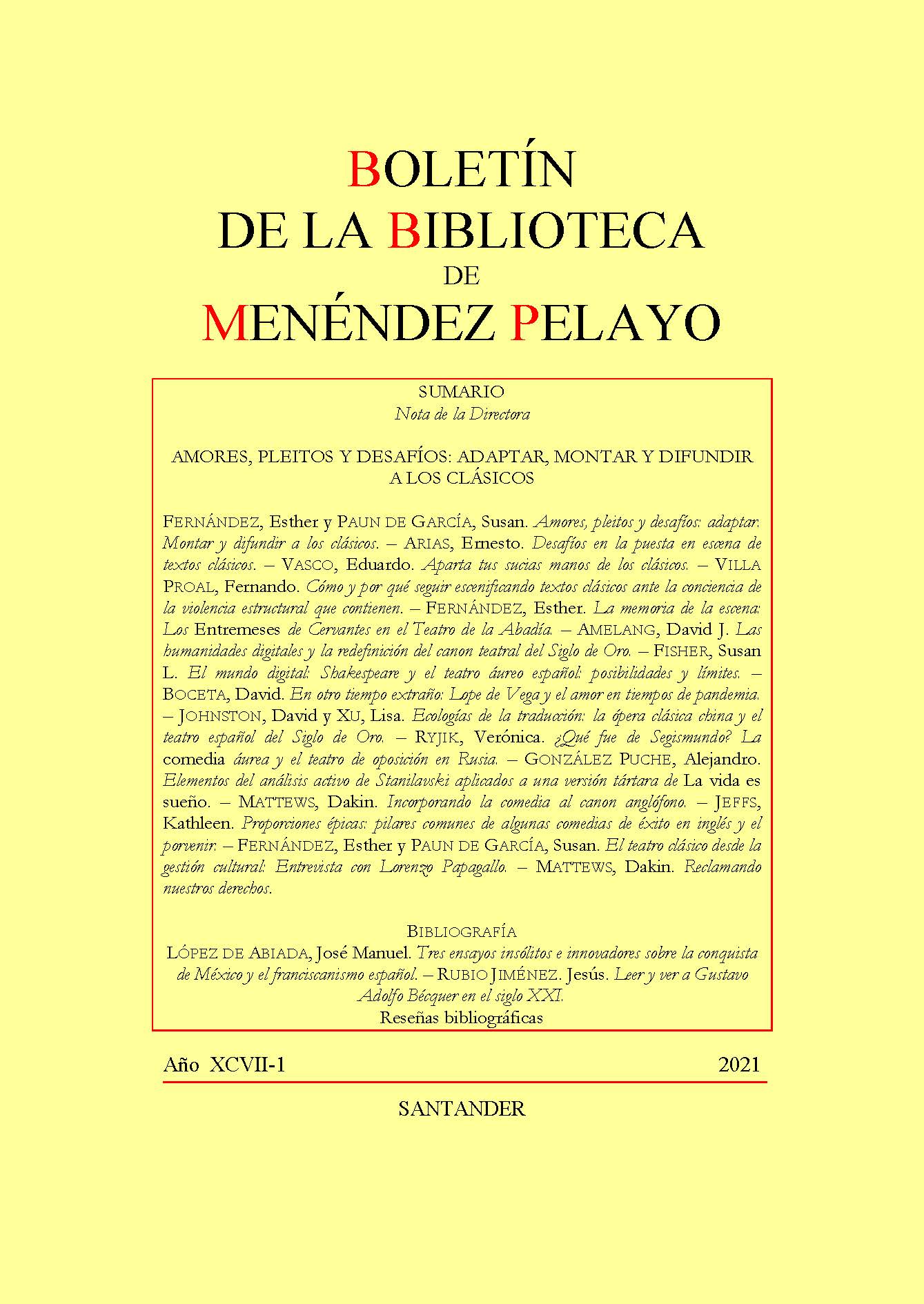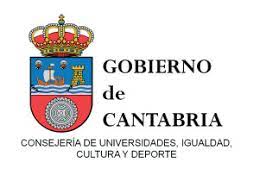What happened to Segismundo?: the golden comedy and the opposition theater in Russia
DOI:
https://doi.org/10.55422/bbmp.273Keywords:
Reception, Canon, Russia, Ideology, Performance historyAbstract
Russian theater directors of the Soviet and post-Soviet eras have shown little interest in exploring the possibilities for critical and ideological reflection on their country’s contemporary realities through adaptions of Spanish Golden Age theater. This article examines the possible reasons behind this lack of interest. There seem to be obvious opportunities to draw symbolic parallels between characters such as Fernán Gómez de Guzmán, the Duke of Ferrara, King Basilio or even Segismundo and different authoritarian leaders that have governed Russian society in the twentieth and twenty-first centuries, in the same way that the post-Stalinist Thaw-era Russian stagings of Hamlet turned Shakespeare’s Elsinore into a metaphor for totalitarian regime. However, despite the Spanish comedia’s extraordinary popularity among Russian audiences, this type of reading has not yet taken place. My main goal is to map out the Russian stage history of several Golden Age dramas in order to elucidate this phenomenon, as well as to consider possible future directions in the Golden Age theater’s stage canon in Russia.
Downloads
Publication Facts
Reviewer profiles N/A
Author statements
Indexed in
- Academic society
- Sociedad Menéndez Pelayo
- Publisher
- Sociedad Menéndez Pelayo
Global Statistics ℹ️
|
135
Views
|
148
Downloads
|
|
283
Total
|
|
References
ADILLO RUFO, Sergio. (2011). «De Fuente Ovejuna a Ciudad Juárez, o Lope según el teatro del Oprimido». Comedia performance. 9. 143-161. DOI: https://doi.org/10.5325/comeperf.9.1.0143
BACZYŃSKA, Beata. (1991). «La recepción de La vida es sueño en Polonia». Castilla: Estudios de Literatura. 16. 19-38.
BALASHOV, Nikolai. (1974). «Krizis Renessansa i Barokko kak protivostoyaschiye yavleniya v drame nachala XVII v. (Vokrug ‘Kary bez mscheniya’ Lope de Vega i ‘Gamleta’ Shekspira)» [La crisis del Renacimiento y Barroco como fenómenos opuestos en el drama de principios del s. XVII (Acerca de El castigo sin venganza de Lope de Vega y Hamlet de Shakespeare)]. Izvestiya Akademii Nauk SSSR. Seriya literatury i yazyka. 33. 1. 27-43.
BARTOSHEVICH, Aleksei. (2011). «Russki Gamlet: XX vek» [El Hamlet ruso: siglo XX]. Teatr. 2. http://oteatre.info/russkij-gamlet-xx-vek/
BELOV, G. (1962). «Gueni ispanskoi stseny» [El genio de la escena española]. Teatralnaya zhizn. 22. 31.
BIRIUKOV, Serguéi. (2015). «Prints i drakony» [El príncipe y los dragones]. Trud. 13 de noviembre. https://www.trud.ru/article/13-11-2015/1330993_prints_i_drakony.html
CARREÑO, Antonio. (1998). «Introducción». El castigo sin venganza. Lope de Vega. Antonio Carreño (ed.). 3ª ed. Madrid. Cátedra. 15-86.
CONROY MOORE, Tiffany Ann. (2012). Kozintsev’s Shakespeare Films Russian Political Protest in Hamlet and King Lear. Jefferson, NC & London.
McFarland & Company.
DERZHAVIN, Konstantin. (1954). «Dramaturguiya Lope de Vega» [La dramaturgia de Lope de Vega]. Izbranniye dramaticheskiye proizvedeniya.
Lope de Vega. Mijaíl Kazmichov (ed.). Moscú. Iskusstvo. 3-50.
DOLZHANSKI, Roman. (2015). «Smert v shesti deistviyaj: ‘Stoiki printsip’ v elektroteatre Stanislavski» [La muerte en seis actos: El principio constante en el Electroteatro Stanislavski]. Kommersant. 12 de noviembre. 11.
DZHIVELEGOV, Aleksei y Grigori BOYADZHÍYEV. (1941). Istoriya zapadnoyevropeiskogo teatra ot vozniknoveniya do 1789 goda [Historia del teatro de la Europa occidental, desde los orígenes hasta 1789]. Moscú. Iskusstvo.
FERNÁNDEZ, Esther. (2014). «La justicia está en la mujer: Fuenteovejuna a través de la mirada de Laurencia». Diálogos en las tablas: Últimas tendencias de la puesta en escena de los clásicos españoles. María Bastianes y Purificació Mascarell (eds.). Kassel. Edition Reichenberger. 141-153.
GARCÍA LORENZO, Luciano. (2000). «Puesta en escena y recepción de Fuente Ovejuna (1940–1999)». Otro Lope no ha de haber: atti del ConvegnoInternazionale su Lope de Vega, 10–13 febbraio. Maria Grazia Profeti (ed.). Vol. 2. Florencia. Alinea. 85-105.
GARCÍA-REIDY, Alejandro. (2009). «Prólogo». El castigo sin venganza. Lope de Vega. Alejandro García-Reidy (ed.). Barcelona. Crítica. 7-76.
GITLITZ, David M. (1980). «Ironía e imágenes en El castigo sin venganza». Revista de Estudios Hispánicos. 14. 1. 19-41.
GUETASHVILI, Nina. (2004). «Fuente Ovejuna Lope de Vega. Gosudarstvenny dramaticheski teatr im. V. I. Lenina (byvshy ‘Solovtsov’). Kiev. 1919» [Fuente Ovejuna de Lope de Vega. El Teatro Dramático Estatal de V. I. Lenin (antes ‘Solovtsov’). Kiev. 1919]. Spektakli dvadtsatogo veka. A. Bartoshevich (ed.). Moscú. GITIS. 61-65.
GUINKO, V. (2006). «Kalderon v Rossii» [Calderón en Rusia]. Pedro Kalderon de la Barca. Bibliograficheski ukazatel. Yuri Fridshtein (ed.). Vol. 2 de Judozhestvennaya literatura Ispanii v russkoi pechati. Moscú. Rudomino. 5-34.
IGNÁTOV, Serguéi. (1939). Ispanski teatr XVI-XVII vekov [El teatro español de los siglos XVI-XVII]. Moscú. Iskusstvo.
ISAYEVA, Natalia. (2016). «Podzemniye vody i viazki ogon: ‘Stoiki printsip’ Borisa Yujananova» [Las aguas subterráneas y el fuego viscoso: El principio constante de Borís Yujanánov]. Teatr. 23. 16-21.
JOROL, V. (1970). «K. A. Mardzhanov na Ukraine» v 1907-1908 gg» [K. A. Mardzhánov en Ucrania en 1907-1908]. Spektakl zvavshi v boi. Sbornik statei i vospominani. M. Gorodisski y V. Nelli (eds.). Kiev. Mistetsvo. 39-40.
KRZHEVSKI, Borís. (1960). Statii o zarubezhnoi literature [Ensayos sobre la literatura extranjera]. G. Stepanov (ed.). Moscú. Gosudarstvennoye izdatelstvo judozhestvennoi literaturi.
KRYZHITSKI, Gueorgui. (1957). «Fuente Ovejuna». Teatr. 7. 124-32.
-----. (1976) Dorogui teatralniye [Los caminos teatrales]. Vol. 2. Moscú. Vserossiiskoye Teatralnoye Obschestvo.
LENDOVA, V. (1972). «Nerastorzhimiye sviazi» [Unos vínculos indisolubles]. Teatr. 4. 79-83.
LUNACHARSKI, Anatoli. (1958). O teatre i dramaturgii [Sobre el teatro y la dramaturgia]. Vol. 2. Moscú. Iskusstvo.
MAY, T. E. (1960). «Lope de Vega’s El castigo sin venganza: The Idolatry of the Duque de Ferrara». Bulletin of Hispanic Studies. 37. 154-82. DOI: https://doi.org/10.1080/1475382602000337154
MENÉNDEZ PELAYO, Marcelino. (1910). Calderón y su teatro. Madrid. Impr. de la «Revista de Archivos».
MOKULSKI, Stefán. (1956). «Zarubezhnaya klassika v repertuare sovetskogo teatra» [Los clásicos extranjeros en el repertorio del teatro soviético]. Bogatstvo dramaturguicheskoi klassiki – sovetskomu zriteliu (sbornik statei). A. Gatenian (ed.). Moscú. VTO. 115-43.
MONFORTE DUPRET, Roberto. (2008). «Recepción y escenificación del teatro clásico español en Rusia durante el siglo XX». Clásicos sin fronteras, número monográfico de Cuadernos de Teatro Clásico 24. Javier Huerta Calvo (ed.). Vol. 2. Madrid. Compañía Nacional de Teatro Clásico. 71-114.
OSIŃSKA, Katarzyna. (2017). «Del Siglo de Oro español a la vanguardia: Vsévolod Meyerhold». El texto dramático y las artes visuales: el teatro español del Siglo de Oro y sus herederos en los siglos XX y XXI. Urszula Aszyk, Juan Manuel Escudero Baztán y Marta Pilat Zuzankiewicz (eds.). New York. Instituto de Estudios Auriseculares. 221-239.
PAVLENKO, Anna. (2016). «Zhiznestoikost i smerteustoichivost» [La resiliencia de la vida y de la muerte]. Luchshi iz mirov. 4 de abril. https://borisyukhananov.ru/archive/item.htm?id=905
PÉREZ-MAGALLÓN, Jesús. (2010). Calderón. Icono cultural e identitario del conservadurismo político. Madrid. Cátedra.
RADINSKI, Aleksei. (2004). «Andrei Prijodko: liubov kak metod» [Andrei Prijodko: el amor como un método]. Zerkalo nedeli, 24 de septiembre. https://zn.ua/ART/andrey_prihodko_lyubov_kak_metod.html
RYJIK, Veronika. (2019a). ‘La bella España’: el teatro de Lope de Vega en la Rusia soviética y postsoviética. Madrid/Frankfurt. Iberoamericana/Vervuert. DOI: https://doi.org/10.31819/9783954877850
— (2019b). «La recepción de Fuente Ovejuna en Rusia». Fuente Ovejuna (1619-2019). Pervivencia de un mito universal. Javier Huerta Calvo (ed.). Maša Kmet (coord.). New York. IDEA. 255-72.
RYZHOVA, V. (1962). «Nakazanie bez mscheniya» [El castigo sin venganza]. Moskovskaya Pravda. 9 de diciembre. 3.
SHTEIN, Abram. (1961). «Svoyeobraziye ispanskoi klassicheskoi drami» [La singularidad del drama clásico español]. Voprosi literaturi. 1. 133-49.
SILIUNAS, Vidas. (1995). «El teatro del Siglo de Oro español. Interpretación escénica y crítica en Rusia». Actas de la I Conferencia de Hispanistas de Rusia, Moscú, Universidad Lingüística Estatal, 9–11 febrero 1994. Embajada de España en Moscú (ed.). Madrid. Ministerio de Asuntos Exteriores. 9–11.
-----. (2000). «Calderón en Rusia y Unión Soviética en el siglo XX». Calderón en escena: siglo XX. Madrid. Consejería de Cultura de la Comunidad de Madrid. 181-89.
SMELIANSKY, Anatoly. (1999). TGuhe Russian Theatre after Stalin. Patrick Miles (trad.). Cambridge. Cambridge UP.
SPASSKI, Yuri. (1935). «Gumanist v riase sviateishei inkvizitsii» [Un humanista en el hábito de la Santa Inquisición]. Literaturnaya gazeta. 24 de agosto. 5.
TOMASHEVSKI, Nikolái. (1961). «Teatr Kalderona» [El teatro de Calderón]. Obras dramáticas. Pedro Calderón de la Barca. Nikolái Tomashevski (ed.). Vol. 1. Moscú. Iskusstvo. 5-46.
UZIN, Vladímir. (1950). O razdele programmy ob ispanskom teatre. Stenogramma konferentsii po teatrovedeniyu. 22 fevralia 1950, [Sobre la sección del programa del teatro español. Estenograma de la comunicación sobre la teatrología. 22 de febrero de 1950]. Archivo del Museo Estatal de Teatro A. A. Bajrushin. Fondo 519. Inventario 1. Unidad 15.
-----. (1956). «Ispanski teatr» [El teatro español]. Istoriya zapadnoyevropeiskogo teatra. Vol. 1. Grigori Boyadzhíyev (ed.). Moscú. Iskusstvo. 253-386.
VEGA CARPIO, Lope de. (1962). Nakazanie bez mschenia [El castigo sin venganza]. Traducción y versión escénica de Vladímir Soloviov. Moscú. Otdel
raspredeleniya dramaticheskij proizvedenii VUOAP.
-----. (1993). El castigo sin venganza. Edición, introducción y notas de Antonio Carreño. Madrid. Cátedra.
VIPPER, Yuri. (1954). «Tvorchestvo Lope de Vega y ispanskaya dramaturguiya XVII veka» [La obra de Lope de Vega y la dramaturgia española del siglo XVII]. Kurs lektsi po istorii zarubezhnyj literatur XVII veka. Y. Vipper y R. Samarin. S. Ignátov (ed.). Moscú. Izdatelstvo Moskovskogo
Universiteta. 661-703.
WEINER, Jack. (1970). Mantillas in Muscovy: the Spanish Golden Age Theater in Tsarist Russia, 1672-1917. Humanistic Studies 41. Lawrence.
University of Kansas Publications.
-----. (1982). «Lope de Vega’s Fuenteovejuna Under Tsars, Commissars, and the Second Spanish Republic (1931-1939)». Annali Dell’ Instituto Universitario Orientali: Sezione Romanza. 24. 1. 167-223.
YUJANÁNOV, Borís. (2013). «Stoiki printsip»: tekst ot rezhissera [El principio constante: el texto del director]. https://borisyukhananov.ru/archive/item.htm?id=2094
YURÉNEVA, Vera. (1946). Zapiski aktrisy [Apuntes de la actriz]. Moscú. Iskusstvo.
Downloads
Published
How to Cite
Issue
Section
License
Copyright (c) 2022 Verónica Ryjik

This work is licensed under a Creative Commons Attribution-NonCommercial 4.0 International License.







